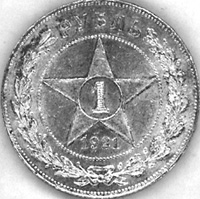NUMISMATIC MAP OF UKRAINE
<h2> From St. Volodymyr to Our Day</h2>
The 1917 October Revolution in the Russian Empire became a hard, if not fatal, ordeal for finances ruined by the war that had been going on for over three years. Any kind of coins (gold, silver, or copper) in fact disappeared. A similar situation existed in Austria- Hungary which incorporated Eastern Galicia, Transcarpathia, and Northern Bukovyna populated by Ukrainians.
This brought a period of the unlimited issuance of paper money (Notgeld, literally, emergency money) secured by nothing. It was impossible to exchange these banknotes for gold or silver, while inflation skyrocketed.
One could only dream about coins in money circulation before 1921, when the last major Civil War battles on Ukraine’s territory thundered. That war resulted in new realities in the life of the Ukrainian ethnic group.
Most of the Ukrainian lands found themselves within a newly-formed state, the RSFSR, and from December 1922, the USSR. Eastern Galicia with Lviv became, under the Riga Treaty of 1921, part of reborn Poland, the third Polish Commonwealth. Transcarpathia merged as an autonomous province with Czechoslovakia, a complex multiethnic entity. Northern Bukovyna and Southern Besarabia went to Romania. Accordingly, the coin systems of those countries were in force on those territories.
In March 1921, the RSFSR Peoples Commissariat of Finance decided to begin the issue of silver coins, and in April of the same year it was decided to restore the Petrograd Mint which soon minted 10, 15, and 20-kopeck coins (all 500 fine), as well as 50 kopeck and one ruble coins (of the 900 purity). By quality, they were absolutely identical to Tsarist minted coins, so the people did not have to get used to the new coins. Only the 25 kopeck coin was not issued. The one ruble and 50 kopeck RSFSR coins were issued in 1921-1922, and those of 10, 15 and 20 kopecks in 1921-1923. The obverse bore the state emblem and the reverse a wreathed star and the face value.
In November 1922 the Soviet government decided to mint the gold coin known as the chervonets. In 1923 they issued the chervonets exactly corresponding in standard to the pre- Revolutionary chervonets (10 rubles) and mostly intended for making settlements with other countries. However, the RSFSR silver coins were only put into circulation in 1923.
1924 saw the beginning of the issue of USSR silver and copper coins. The 1-ruble coin was only minted in that year, while the fifty kopeck one (poltinnik) was issued from 1924 to 1927. Numismatists call the RSFSR coins stars and those of the USSR blacksmiths. The RSFSR official emblem gave way to that of the USSR. Copper 2, 3, and 5 kopeck coins were issued only in 1924, and those of one kopeck in 1924-1925. Externally, they were an exact replica of the silver nominal-value coins. 1925-1928 also saw the minting of a half kopeck coin. In 1926 the mint began to strike bronze coins patterned after previously issued copper ones. Small-denomination silver coins were issued in the USSR until 1931, but then the government began to issue 10, 15, and 20-kopeck coins in nickel.
The types of coins established in 1935 lasted until 1961. They sacrificed the slogan, Workers of the whole world, unite, previously struck on the obverse. It is also interesting that, as the number of USSR constituent republics increased, the number of the spirals of ribbons that girded the wheat ears also changed. They were 15 from 1957, when the Karelian-Finnish SSR was disbanded, until 1991.
The 1961 monetary reform (at 1:10) also touched coins. For exaple, the 1, 2, and 3 kopeck fractional coins were not subject to exchange and remained in circulation, while 10, 15, and 20 kopeck coins were struck of a copper-nickel alloy. Ruble and 50 kopeck copper-nickel coins were also minted. In 1965, in honor of the twentieth anniversary of victory over Nazism, the government put into circulation the first Soviet commemorative coins, so far of the one ruble denomination. The USSR issued the following coins until its collapse in 1991: 1 ruble, 50, 20, 15, 10, 5, 3, 2, and 1 kopecks. Also issued were other numerous types of commemorative coins. Some were made of precious metals: gold, silver, and even platinum. Precious-metal coins were in fact missing from circulation.
The third Polish Republic (1918- 1939) had a rather streamlined system of finances. In 1924 Poland introduced, as part of the gold standard, the zloty, divided into 100 groszy, under an arrangement patterned after the French system. In 1923 Poland also issued 1, 2, and 5-groszy bronze coins and 10, 20, and 50 groszy nickel ones. 2, 5, and 10 zloty coins were minted in 750 fine silver.
Czechoslovakia (1919-1939) had a monetary unit called koruna minted for the first time in 1922 from a copper-nickel alloy. Until occupied by the Nazis in 1939, that country issued 5, 10, and 20 koruna silver coins (700 fine). The heller was the fractional coin.
The monetary unit of Rumania was the leu, divided into 100 bani. The leu was also pegged to the French franc for a long time.
(See one of the next Ukrayina Incognita pages for an overall concept of our national numismatics.)
№3 February 01 2000 «The
Day»
In using our publications, reference to The Day is
mandatory. © "День"






